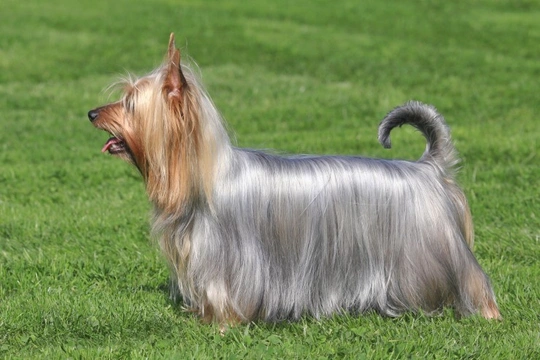
Five interesting facts about the silky terrier
The silky terrier or Australian silky terrier looks very similar to the Yorkshire terrier at a glance-and the two breeds are in fact very close relatives. However, if you find yourself looking at a Yorkshire terrier type with a long, luxurious coat that almost seems to glow because it is so sleek and smooth, the chances are that you are looking at a silky terrier, rather than their closer to home relatives!
They are one of the world’s smallest dog breeds, even coming in the tiny teacup size-which makes them a good pick for people who live in smaller homes. These soft, loving and very affectionate little dogs have won hearts and minds all over the globe, not least in their native country of Australia.
If you are considering buying or adopting a silky terrier or simply want to find out more about them-including how they are related to the Yorkshire terrier, as well as how they differ-this article is for you! Read on to learn five interesting facts about the silky terrier, their origins, and why they make for great, albeit very lively little companions.
The Australian connection
The silky terrier does, as mentioned, look very much like a Yorkshire terrier, and the Yorkie is in fact a very close relative of the breed. However, both breeds are now recognised individually, although they only diverged during the 20th century, making the silky terrier one of the more modern widely recognised breeds.
The silky terrier was developed during the early part of the 20th century by immigrants to Australia-generally from the UK-who took Yorkshire terriers with them, and consequently crossed them with native Australian terriers that they found in the New World.
The breed’s earliest foundations and the formalisation of the silky as a breed in its own right took place in Sydney and the surrounding suburbs, with the breed first gaining recognition by international Kennel Clubs in the UK and USA from 1955 onwards, making it a rather modern new breed.
They have also gone by various different names since this time, including the silky terrier, Australian silky terrier, Sydney silky, and simply silky.
Similarities with the Yorkshire terrier
Due to the very recent recognition of the breed, their entire history is fairly well known, back to the point at which they diverged from the Yorkshire terrier itself and beyond.
As mentioned, Yorkshire terriers imported to Australia were crossed with local Australian dogs-mainly small terriers themselves-to create a hybrid breed that retained many of the original Yorkshire terrier traits.
The Silky terrier is, like the Yorkshire terrier, a small toy dog, with a coat colour that is referred to as blue and tan. The blue shade is in fact a steely grey colour, and the silky can only be found in this shade, unlike the Yorkshire terrier, which has more range for colour variation within the breed standard.
Also, while the texture of the Yorkshire terrier can be smooth, rough or broken-and vary in length-the silky terrier’s coat is always smooth and long, and this is the core trait that sets the two breeds apart.
Coat care
The blue part of the silky terrier’s coat should glow and shine with lustre, and the length of the coat means that they need quite a lot of upkeep in terms of brushing and grooming! They need to be brushed and combed on a daily basis to prevent their fur knotting and matting up, and they must be groomed right down to the skin, otherwise they are apt to get knotted up in problem areas, such as under the belly and in the armpits.
Also, because they are small dogs that are low to the ground, they tend to get mucky and pick up dirt and debris with ease, which all contribute to this very small dog breed having one of the highest levels of care requirements when it comes to their coats.
Pets and companions
While the silky terrier is a toy dog that can live happily in suburbia with owners of all ages and from all walks of life, like most small terrier breeds, they are very lively and outgoing!
Not just a pretty face, the silky terrier requires brisk walks and lots of stimulation in order to keep them happy, and they will soon become tiny tearaways if they do not get enough exercise!
However, due to the fact that they are small and short-legged, this means that vigorous exercise for these little dogs could simply mean a half hour brisk walk on a lead, and so they do not need to spend hours every day haring around!
They are sharp and quick
The silky terrier is a very watchful dog, and they also have a strong prey drive! If they catch movement out of the corner of their eye, they will soon forget about their pampered home lives and head off on the chase, which makes them playful and sociable little dogs, that generally get on well with others. They generally get on well with strangers and children, but they can become frightened with a lot of noise or rough and tumble, at which point they will generally retreat or become defensive.
This means that they are a good match for families who do not have very young children, but they may find life with toddlers and very energetic kids a little bit too much.



